Thursday 31 October 2013
scholarshipjobsngoafrica: Overseas Lifestyle Blogger
scholarshipjobsngoafrica: Overseas Lifestyle Blogger: Overseas Lifestyle Blog is looking for a Overseas Lifestyle Blog Seeks Writers to Land and Write Guest Posts Description We are l...
CAMEROON FILM INDUSTRY RELEASES U-TURN

The Cameroon Film industry is once again gaining grounds in the world's entertainment in the line of motion pictures. With a grand premier held in Akwa- Douala of the must watched movie to be released latter this year, “U-Turn”.
U-TURN is based a a true life story on the political crises of the country and questions the position of the youths on the promotion and practice of democracy. There arose a young leader – Enow – who comes up from Germany to change the game in his home country amidst wolves and he is not given the mandate to preach on what is right or wrong except he’s been elected. Things fell apart; his life endangered, his kid kidnapped and his wife threatens to leave and his dreams start to crumble. Should the hero continue to preach on this far-fetched topic or bow out before his family is completely wiped out by those at the top?

U-Turn stars a clutch of Cameroon’s finest stars including; Jeffery Epule, Nchifor Valery, Otia Vitalis, Quinta Eyoh, Ayuk Tambi and others. Amongst the crew members are renowned filmmakers such as Peter Njodzeka aka Penjo, Tanwie Elvis, Stanley Miki and Mandi Priscilia. This movie is out to win Awards.
U-Turn is produced by Achu Egbe and directed by Kamwa Anthony. The film was shot in Cameroon.
Doctor Sley, Africa’s Reggae Soul Messenger launched his debut album titled, ‘Inspired ’

Doctor Sley, Africa’s Reggae Soul Messenger launched his debut album titled, ‘Inspired ’with a free live concert and reggae party on Saturday October 12,2013, in Buea.
This album titled “Inspired” presents a unique inspiring and revolutionary message of a new kind of love, belief and hope for Africa.
Are you sick of reggae militis? Come have some dose of reggae music. Buea will be Jamaica come October 12, 2013.
Wednesday 30 October 2013
Suzie Ukum Releases Another power single
The spirited, anointed singer with a magic voice will son release a full album "Arise and Shine"


She explains "WHEN U FEEL LIKE EVERY DOOR IN UR LIFE HAS BEEN SHOT DOWN, REMEMBER DAT U HAVE A GOD WHO WILL OPEN BETTER DOORS FOR U. ( YES HE WILL !!!!! )
AFTER THE SORROW AND PAIN, THEN COMES JOY, HOLD ON TIGHT TO UR GOD COS HE'LL NEVER LEAVE U."
You can get more at www.soundcloud.com/suzieukum/yeshewill
Forbes releases World's Most Powerful list
OBAMA SECOND?
Forbes just released its World's Most Powerful People list and put Russian president Vladamir Putin ahead of US president Barack Obama. The first African Dangote on #64. That is really socking
Will Yaya Toure be Crowned Best player of the year?
Gnégnéri Yaya Touré, commonly known as Yaya Touré, is an Ivorian footballer who plays as a midfielder for Premier League club Manchester City and the Ivory Coast national team.
(1) Gareth Bale (Real Madrid/Wales)
(2) Philipp Lahm (Bayern Munich/Germany)
(3) Thomas Muller (Bayern Munich/Germany)
(4) Manuel Neuer (B ayern Munich/Germany)
(5) Bastian Schweinsteiger (Bayern Munich/Germany)
(6) Mesut Ozil (Arsenal/Germany)
(7) Robin van Persie (Man United/Netherlands)
(8) Arjen Robben (Bayern Munich/Netherlands)
(9) Edinson Cavani (PSG/Uruguay)
(10) Luis Suarez (Liverpool/Uruguay)
(11) Andres Iniesta (Barcelona/Spain)
(12) Xavi (Barcelona/Spain)
(13) Neymar (Barcelona/Brazil)
(14) Thiago Silva (PSG/Brazil)
(15) Radamel Falcao (Monaco/Colombia)
(16) Andrea Pirlo (Juventus/Italy)
(17) Frank Ribery (Bayern Munich/France)
(18) Cristiano Ronaldo (Real Madrid/Portugal)
(19) Eden Hazard (Chelsea/Belgium)
(20) Zlatan Ibrahimovic (PSG/ Sweden)
(21) Robert Lewandowski (Dortmund/Poland)
(22) Lionel Messi (Barcelona/ Argentina)
(23) Yaya Toure (Manchester City/Ivory Coast)
Coach of the Year
(1) Carlo Ancelotti (Real Madrid)
(2) Rafael Benitez (Napoli)
(3) Antonio Conte (Juventus)
(4) Vicente Del Bosque (Spain)
(5) Sir Alex Ferguson (ex-Manchester United)
(6) Jupp Heynckes (ex-Bayern Munich)
(7) Jurgen Klopp (Borussia Dortmund)
(8) Jose Mourinho (Chelsea)
(9) Luiz Felipe Scolari (Brazil)
(10) Arsene Wenger (Arsenal)
Saturday 19 October 2013
African Countries of the Future 2013/14
fDi magazine releases the African country of the future


South Africa has been crowned as the African Country of the Future for 2013/14 by fDi Magazine, with Morocco in second position and Mauritius in third. New entries into the top 10 include Nigeria and Botswana. Jacqueline Walls reports.
One of the economic powerhouses of the African continent, South Africa has been named fDi Magazine’s African Country of the Future 2013/14. A worthy winner, South Africa has consistently outperformed its African neighbours in FDI attraction since fDiMarkets records began in 2003. Figures for 2012 build upon South Africa’s historical prominence as an FDI destination with the country attracting about one-fifth of all investments into the continent – more than double its closest African rival, Morocco. In 2012, FDI into South Africa amounted to $4.6bn-worth of capital investment and the creation of almost 14,000 jobs.
In the five years or so since the financial crisis made its impact felt, global FDI remains 20% lower than figures recorded in 2008. Any hints of global recovery in FDI in 2010 and 2011 have been overshadowed by the 14.3% decline in 2012. In the context of this decline, the number of investments into the African continent fell to a lesser extent than any other world regions, down 7.9% in 2012. However figures for the first five months of 2013 signal that FDI into Africa is falling at about the same rate as global averages, down 27% compared to 28% globally.
Unrest, corruption and severe income disparities persist in Africa, though an emerging middle class with increased disposable income, a marked improvement in governance and the availability of natural resources present an attractive opportunity for investors. According to a recent report by the African Development Bank, Africa’s economy is growing faster than any other continent. Of the 54 African countries, 26 have now achieved middle-income status, with some countries, such as South Africa, Morocco and Mauritius, significantly outperforming the likes of Somalia and the Democratic Republic of Congo.
South Africa's resilience
South Africa claimed the title of fDi’s African Country of the Future 2013/14 by performing well across most categories, obtaining a top three position for Economic Potential, Infrastructure and Business Friendliness. Its attractiveness to investors is evident in its recent FDI performance, where the country defied the global trend with 2011 and 2012 figures surpassing its pre-crisis 2008 statistics. Despite a slight decline of 3.9% in 2012, South Africa increased its market share of global FDI, which further increased in the first five months of 2013 as the country attracted 1.37% of global greenfield investment projects. According to fDi Markets, South Africa now ranks as the 16th top FDI destination country in the world.
South Africa’s largest city, Johannesburg, was the top destination for FDI into Africa and is one of only five African cities that attracted more investments in the first five months of 2013 compared to the same period of 2012. South Africa ranked third behind the US and the UK as a top source market for the African continent in 2012, accounting for 9.2% of FDI projects.
In 2010, South Africa became the ‘S’ of the BRICS – five major emerging national economies made up by Brazil, Russia, India and China. While FDI into South Africa fell 3.9% in 2012, this was the lowest recorded decline of the BRICS grouping which, on average, experienced a 20.7% decline in FDI. In its submission for fDi’s African Countries of the Future 2013/14, Trade and Investment South Africa (TISA) stresses the importance of the country's attachments to its BRICS partners. “South Africa’s participation in the BRICS grouping is significant… as it provides important opportunities to build South Africa’s domestic manufacturing base, enhance value-added exports, promote technology sharing, support small business development and expand trade and investment opportunities,” says TISA.
Familiar look at the top
South Africa, Morocco and Mauritius have maintained their top three positions in the ranking, though Morocco has been ousted from the top spot in part due to its 17% FDI decline in 2012. Home to the Tangier Free Zone (ranked sixth in fDi’s Global Free Zones of the Future 2012/13), Morocco still provides a healthy FDI story, attracting 8.3% of all investments into Africa last year. The country ranked second in the Infrastructure category and joint top for FDI Strategy.
Egypt ranks fourth in fDi’s African Countries of the Future 2013/14 table. However, as these results went to press, turmoil erupted in the country following the ousting of its president, Mohammed Morsi. As fDiMagazine’s African Countries of the Future ranking is primarily based on the analysis of FDI data, it is important to note that prior to the current political situation, the country had witnessed a 20% increase in inward investment in 2012.
Kenya has climbed the overall rankings, moving from 10th in the 2011/12 ranking to fifth position this year. Since 2008, FDI into the country more than doubled and the latest figures from fDi Markets show that Kenya has already attracted 9.43% of inward investment into Africa in the first five months of 2013. Currently, Kenya ranks second behind South Africa as the top FDI destination in 2013. Kenya continues to diversify its economy and the widely adopted use of M-Pesa mobile payment has opened the door to many new investment opportunities. Nigeria and Botswana are the new entrants in the top 10, ranking in seventh and eighth place, respectively.
Places of potential
South Africa is top of the Economic Potential table. The country's GDP stands at more than $5.8bn and it is the largest economy in Africa. South Africa has attracted more R&D investments than other African country and accounts for the largest number of patents registered in the continent. Exports from the country increased 24% in 2011 whereas imports increased 18% when compared to 2010 figures, and both were more than 13% higher than 2008 levels.
Nigeria comes in second behind South Africa in the Economic Potential category. Despite major issues such as corruption, security and infrastructure inadequacies blighting the country in recent years, Nigeria has seen its GDP almost treble since the turn of the century. According to the Nigerian Investment Promotion Commission’s submission for fDi’s African Countries of the Future, the Nigerian government is keenly aware that major issues need to be tackled in order for the country to unlock its potential. To address this, it says the government has “implemented various improvement measures in order to reach its goal of being one of the world's 20 largest economies by 2020.”
Following a slight decline in FDI in 2009/10, investments into Nigeria increased 41% in 2011 and a further 20% in 2012. The oil industry is a dominant feature of the Nigerian economy, though the communications sector is also a strong area of growth. According to fDi Markets, FDI in the communications sector accounted for one-quarter of all investments in the country in 2012, and as penetration levels remain relatively low in this large and growing consumer market, this sector continues to offer huge opportunities to existing and new players alike.
A new entrant into the top 10 for Economic Potential, Kenya ranked third thanks largely to its strong performance in FDI attraction. Kenya’s capital, Nairobi, was the fastest growing African city for FDI between 2009 and 2012 and was second only to Johannesburg as a destination for FDI in 2012. Many initiatives are currently being developed to drive the Kenyan economy and in turn encourage investors into the country. In its submission for fDi’s African Countries of the Future, KenInvest says: “The development of the national investment policy… is aimed at streamlining the investment promotion and facilitation process in Kenya to make it simpler. Full implementation of the… new constitution is on its own expected to increase the level of foreign participation in the country”.
A well-administered country by regional standards, Ghana ranks fourth in the Economic Potential category of fDi’s African Countries of the Future 2013/14. In the past few years, Ghana has attracted its largest ever FDI project following the discovery of major offshore oil reserves in 2007. In July 2009, South African company New Alpha Refinery announced plans to construct a new $6bn oil refinery in Accra in what will be the largest refinery in west Africa. With production set to begin in 2015, the refinery should initially produce 200,000 barrels of oil per day with a view to eventually doubling capacity.
Labour and costs
Mauritius tops the table in Africa when it comes to the Labour Environment category. With a reputation for political and social stability, Mauritius is recognised as a middle-income country with a greater degree of equality compared with other African nations. High-end FDI has been a boon to Mauritius, with more than half of all inward investment involved in the business and financial services sectors. On its own, Mauritius's financial services sector accounts for 13% of the country's GDP and directly employs more than 15,000 highly skilled professionals.
Tunisia ranks second in the Labour Environment category. Currently undergoing great social and political change, Tunisia has one of the top tertiary education enrolment rates in Africa, combined with a comparatively high life expectancy. Being home to eight of Africa’s top 200 universities has helped Egypt place in third, while Algeria and Libya complete the top five.
Madagascar is the leading African country in the Cost Effectiveness category. Low wages combined with low property costs have helped Madagascar attract investors involved in manufacturing and extraction, with these activities accounting for 40% of investments on the island. One of the world's poorest countries, Mauritania is in second place in this ranking. Although rich in natural reserves, the country has been unable to capitalise on its discovery of oil in 2001.
Infrastructure issues
Despite the continent experiencing some economic growth, Africa's infrastructure remains a major constraint that hinders its ability to unlock its vast human and economic potential. Africa only invests 4% of its collective GDP in its infrastructure.
Egypt offers one of the more advanced infrastructure set-ups in Africa, and as such is awarded the top spot in our Infrastructure category. Prior to the unrest that the country is currently experiencing, Egypt had a thriving tourist industry which accounted for more than 10% of its economic output. Airports in Egypt offer connections to more than 100 international destinations, and the country is also home to a number of significant ports due to its strategic location between Europe, Africa and the Middle East. Egypt also has one of the highest rates of internet usage in Africa.
Morocco is another African country with a relatively well developed infrastructure system. Moroccan airports are connected to more than 80 international destinations and its largest city, Casablanca, is home to the second largest port in Africa. Future infrastructure projects for Morocco include a $35bn investment in its rail networks as well as the development of the world’s largest solar power plant, which commenced construction in May 2013.
South Africa is in third place in the Infrastructure category. The South African government has set out plans to invest $92bn in its infrastructure over the next three years. The biggest chunk of the investment will come from the South African electricity utility company Eskom, and incorporates plans for two new power stations, Medupi and Kusile, which are expected to start producing electricity in 2014 and 2015, respectively.
Business friendly?
When it comes to business-friendliness, South Africa is fDi's top African country. A testament to its open and stable business environment, the country boasts the highest cluster of knowledge-based companies. South Africa also recorded the highest number of expansions in the region on the real-time FDI database, fDi Markets, a clear indication that business are happy to do business in the country.
Egypt ranks second for business-friendliness, with fDi Markets recording nine FDI signals (early-warning signs that a company may be considering investment) in the past 18 months. Given the country's current political unrest, it remains to be seen how many of these projects will come to fruition.
With one of the lowest corporation tax rates in the region, Mauritius is third for business-friendliness. According to the latest World Bank Doing Business ranking, Mauritius is the easiest location in Africa for doing business, and is positioned 19th globally.
Comparative strategies
Based on information submitted by African countries with regards to their FDI strategies, Mauritius and Morocco finish joint top of our FDI Strategy category.
Promoting itself as "the jewel of Africa", Mauritius is targeting investors in the financial services, hospitality, property development, IT and business process outsourcing sectors. In its submission, the Mauritian Board of Investment (BOI) looks to the future of the African region, saying: “Since the global investment trend is gradually shifting towards Africa, BOI is positioning itself to play a crucial role in positioning Mauritius as the gateway to this new frontier of growth.”
Morocco’s FDI-friendly environment is encapsulated in Agence Marocaine de Developpement des Investissements' African Countries of the Future submission, which says: “With its solid macroeconomic fundamentals, unique set of free-trade agreements, competitive labour costs, world-class infrastructure, business-friendly environment and attractive set of incentives, Morocco has all the ingredients to become a location of the future.”
One of the world’s largest producers of diamonds, Botswana enjoys stable economic growth, low levels of corruption and a stable political regime, one of the few such success stories in Africa. Botswana Investment and Trade Centre has recently launched a brand awareness scheme with the slogan ‘Go Botswana’ which it states “highlights our national assets, including our people, culture, tourism attractions, business potential and our reputation as a country with good governance.”
Namibia, which is placed in fourth in the FDI Strategy category, highlighted in its submission its efforts to realign its strategy in order to attract future FDI. Its entry states: “To kick-start the process of addressing Namibia’s economic and business ratings, consultations with World Bank experts are already under way. We have established the Business and Intellectual Property Authority (BIPA) to improve service delivery and the effective administration of business and intellectual property rights registration by serving as a one-stop centre. The review of our incentives also cements the country’s commitment to increasing greenfield and brownfield FDI.”
Africa has experienced significant growth in the past decade. However this growth should be viewed in context – the countries on the continent are expanding from a low base and living standards as well as business environments often do not measure up to other world regions. Yet this represents an opportunity for future growth. If the region continues in its efforts to tackle poverty, corruption, inadequate infrastructures and political issues, Africa’s competitiveness on a global scale can only get better.
Methodology
To create the shortlist for fDi African Countries of the Future 2013/14, the fDi Intelligence division of the Financial Times collected data using the specialist online FDI tools fDi Benchmark and fDi Markets as well as other sources. Data was collected for 55 countries under five categories: Economic Potential, Labour Environment, Cost-Effectiveness, Infrastructure and Business Friendliness. A sixth category was added: FDI Strategy. In this category, 20 submissions were received from African countries regarding their current strategy for FDI promotion and this was scored by the judging panel. Countries scored up to a maximum of 10 points under each individual data point, which were weighted by importance to the FDI decision-making process in order to compile both the subcategory rankings, as well as the overall African Countries of the Future ranking.
Friday 18 October 2013
Cell phones worth Gold
Most people enjoy having a quality cell phone, but they also recognize that cellular phones are a consumable good and will have to be replaced within in a few years. For this reason, people often do not purchase the most expensive cell phone when they purchase their mobile. Some, though, must have a costly mobile phone. The world’s most expensive cell phones were made to satisfy just that type of person.
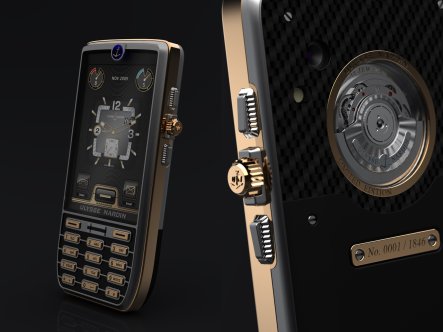
Ulysse Nardin’s The Chairman – up to $49,500
The Chairman by Ulysse Nardin is the world’s most expensive Android smartphone, and includes both a touch screen and a physical number pad. The Ulysse Nardin name is most often associated with luxury watches and that fact shows in the Chairman’s sophisticated design. The volume controls look like watch buttons and the crown between them can actually be wound to generate power for the device. In fact, the phone features a kinetic rotor power system visible through the backplate.
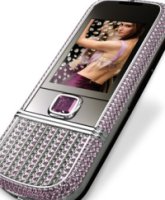
Nokia 8800 Arte with pink diamonds
$134,000
$134,000
Designed by Peter Aloisson, this solid 18k white gold phone features over 680 pink and white brilliant cut diamonds totaling over 21.5 carats. Some of the phone’s features are a 3.15 MP camera with autofocus and video, a music player, Bluetooth and voice memo.
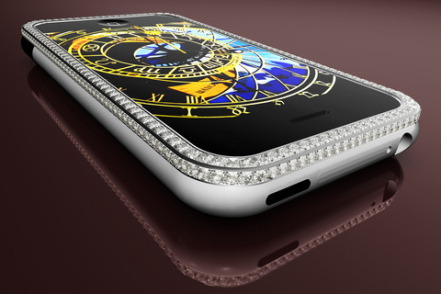
The Princess Plus got its name from the Princess cut used on 138 of the 318 diamonds on its surface. The other 180 diamonds on the phone were brilliant-cut. In total, the phone has 17.75 carats of diamonds set in 18k white gold around its rim. The iPhone Princess Plus is worth $176,400 while the somewhat more pedestrian “Brilliants only” version sold for $66,150.
World's most expensive hotels

Provocateur Suite, Hard Rock Hotel, Las Vegas
Price: $3,500 a night during the week; $7,500 on weekends
The Layout: This suite with two bedrooms (mirrored ceilings in both, of course) is designed as a palace in which to indulge the lower urges—and it’s a riot. You are greeted upon entry by black-vinyl walls and an S&M table. A dark anteroom between the foyer and the master bath features a cage big enough to hold a full-grown man and a set of manacles on chains (but no way to fasten them). The living room has an inlaid carpet made of old black-leather belts.
Bragging Rights: The rumor last June was that Duran Duran had recently checked in.
Favorite Things: A tiled hot tub on a terrace, and planes flying by so close that they look like toys you could pluck from the sky.
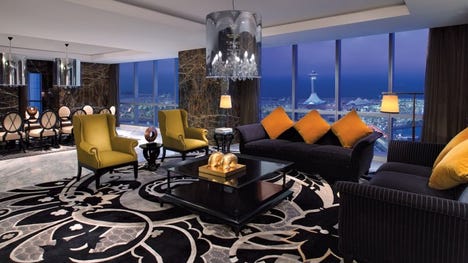
Royal Etihad Suite, Jumeirah at Etihad Towers, Abu Dhabi
: $18,000 per night
The Layout: This four-bedroom, six-bathroom, two–dining room suite takes up the entire sixtieth floor and is so opulent that your eyes pop out on stalks—from the mounds of dates, cookies, and petit fours to the raised green marble tub in one of the bathrooms.
Service: Charming, capable, and proud.
Bragging Rights: The suite has been occupied so little since the marble-lined private elevator first opened into these filthy rich rooms that there’s barely a fingerprint on the many iPads that you can use to close the sheers or summon the butler.
Favorite Things: The Audi A6 airport pickup, the copious Hermès toiletries, and the views.
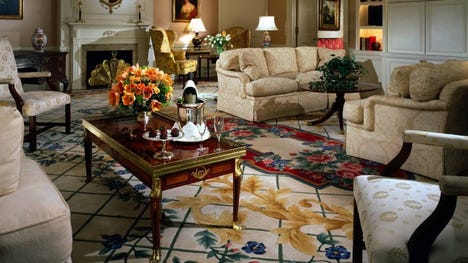
The Presidential Suite, Waldorf Astoria, New York City
Price: Starts at $10,000 per night
The Layout: It’s like staying in a small wing of the Smithsonian. There’s the small, wooden rocking chair given as a gift by John F. Kennedy, between the fireplace and Eisenhower’s desk. In the bedroom—modest in size and somber in décor—you can draft a speech at General MacArthur’s desk, which dates back to the years when he lived at the Waldorf with his wife. Strangely, the windows, that look out onto unremarkable midtown scenes, are not state-of-the-art bullet-proof. The suite contains four bedrooms total, each with a separate key.
Bragging Rights: There are so-called presidential suites all over the globe, but this is the only one where every US president since Herbert Hoover has spent the night.
Favorite Things: The interior looks not unlike the Oval Office, decorated in creams and golds and blues, following the presidential seal—which you’ll find on plates in the dining room’s breakfront and etched into glass on the sconces in the living room.
Splitting Hairs: The hyper-selective booking process. The hotel will obtain background information on new guests to ensure that he or she is "well-known" through either frequency of previous stays and/or fame, and will treat the priceless property with respect. Those who've passed muster: J. K. Rowling, whose seven-volume Harry Potter series sits alongside works by Bill Clinton and Richard Nixon; a Chinese man of means who is obsessed with US history; and special friends of the Waldorf.
Tuesday 15 October 2013
3 Most expensive buildings in the world
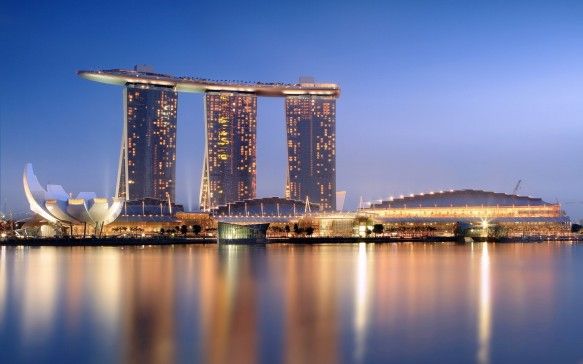
Marina Bay Sands, Singapore – $6 billion
Marina Bay Sands is a 57-storey building that rises 194 meters into the air. Moshe Safdie designed the building that was completed in 2010 at a cost of $5.5 billion at the time. It is actually an integrated resort that fronts Marina Bay in Singapore, covering 20 hectares of property. It has the world’s largest atrium casino, a 340-meter long SkyPark, and a 150-meter infinity swimming pool on top of the largest public cantilevered platform in the world. It features a mall, museum, two large theaters, seven celebrity chef restaurants, two floating Crystal Pavilions and an ice skating rinkResorts World Sentosa, Singapore – $5.38 billion

Resorts World Sentosa was completed in 2010 at a cost at that time of $4.93 billion. It has 10 floors and rises up to 50 meters high. Michael Graves designed the building. It is basically an integrated resort in Sentosa Island off the southern coast of Singapore. It has a casino, a Marine Life Park, the largest oceanarium in the world, and Universal Studios. Genting Singapore developed the property and is considered as one of the most expensive casino properties in the world.
Emirates Palace, Abu Dhabi – $4.46 billion

The Emirates Palace in Abu Dhabi has only six floors and rises up to 72.6 meters. John Elliott did the design and architecture. The building was completed in 2005 at a cost of $3 billion at that time. It is considered a seven-star luxury hotel, with its own marina and helipad. It covers 850,000 square meters of floor space. The hotel is located on 1.3 kilometers of private beach and surrounded by 85 hectares of gardens, with 114 domes approximately 80 meters high.
Rich Magazine Reveals the richest Africans

No.1 Aliko Dangote
Source of wealth: sugar, flour, cement , self-made
Age:54 ,Citizenship: Nigeria , Residence: Lagos, Nigeria
Marital Status: Married, Children:3
Aliko Dangote is Africa’s and Nigeria’s Richest Man as of 2012 according to Forbes Magazine with a net worth of $11.2 billion.
No.2 Nicky Oppenheimer & family

Source of wealth: De Beers, inherited
South Africa’s Richest Person: #1
Age:66 , Citizenship : South Africa , Residence: Johannesburg, South Africa
Marital Status: Married, Children:1
Nicky Oppenheimer is worth $6.8 billion. He is the richest person in South Africa and is the 139th richest person in the world. How did he get rich? He is the chairman of De Beers diamonds, of course, and also has a significant interest in Anglo-American plc, the gold mining company. He also owns Tswalu Kalahari Reserve, the largest private game reserve in South Africa
No.3 Nassef Sawiris (tie)

Egypt’s Richest Person: #1
Source: construction, inherited and growing
Age:51 , Citizenship: Egypt , Residence: Cairo, Egypt
Nassef Sawiris is Onsi’s youngest son and is worth $5.5 billion. He is the richest person in Egypt, and the 199th richest person in the world. He took over leadership of Orascom’s construction and fertiliser division in the late nineties and sold its cement business to Lafarge in 2007, although he still owns a stake and sits on the French company’s board. He is also the largest shareholder in Texas Industries.
No.3 Johann Rupert & family (tie)

Source: Luxury goods, inherited and growing
Age: 61 , Citizenship: South Africa, Residence: Stellenbosch, South Africa
Marital Status: Married, Children:3
Johann Rupert is the second-richest person in South Africa, being worth $5.1 billion. He is the 199th richest person in the world, and made his money from Richemont, the Swiss luxury group that owns Cartier, Dunhill, Chloe bags and MontBlanc pens. The company purchased online fashion portal Net-a-Porter. Remgro, his South African holding company purchased VenFin earlier in 2010. He also owns Rupert & Rothschild and L’Ormarins wine estates, and one of South Africa’s most exclusive golf clubs.
No.5 Mike Adenuga

Source of wealth: Telcom, banking, oil, self-made
Age:58 , Citizenship: Nigeria , Residence:Lagos, Nigeria
Marital Status: Married
Mike Adenuga is the second-richest person in Nigeria with a fortune of $4.3 Billion. He is the 248th richest person in the world and made his money in telecommunications with Globacom, a carrier that has recently launched its 4G network. The company has also invested in the submarine cable connecting Nigeria to the world. His beginnings were small, as he started selling lace and Coca-Cola, but then he finally won a contract to build military barracks in the late 1980s. Adenuga also has a stake in the Equitorial Trust Bank, and is the chair of Conoil.
Sports car guru reveals 2013 most expensive cars

1. Lamborghini Veneno – $3.9 million
| Engine: | 6.5-Liter Naturally-Aspirated V12 | Transmission: | 7-Speed ISR Robotized Manual |
| Top Speed: | 221mph | Weight: | 3,190 lbs (1,450 kg) |
| 0-60 mph: | 2.8 seconds | Power | 750 hp |
| Price: | $3,900,000 | Total Made: | 3 |
It seems as if companies continue to have no limits when they put a price tag on a car, especially with a world full of oil millionairess and rich collectors who will do anything for a rare exotic super car. The Lamborghini Veneno has just recently raised a bar that will most likely never stop rising. Revealed at the 2013 Geneva Motor Show, the Veneno (which in Spanish means “poison”) celebrates 50th anniversary of Lamborghini as a car maker.
Though the Veneno is mainly used for the track, we have included it on our list for the Worlds Most Expensive Cars because it is street legal. Lamborghini went ahead and upgraded the Aventador’s 6.5-liter naturally-aspirated V12 to produce 750 horsepower and strapped in a seven-speed ISR robotized manual gearbox which is then connected to an all-wheel drive system. Top speed is claimed to be 221 mph and a 0-60 is projected to be around 2.8 seconds.
So how much does a carbon-fiber monocoque chassis and carbon-fiber-reinforced-polymer bat-mobile cost? How about $3.9 million (3 million euros or 2.6 million pounds) and only 3 will be made and sold. All of them are already sold, so chances of ever seeing one, is slim to none.

2. W Motors Lykan Hypersport - $3.4 million
| Engine Type: | 6-cylinder twin-turbocharged | Transmission: | ---------- |
| Top Speed: | 245 mph (unverified) | Weight: | ---------- |
| 0-60 mph: | 2.7 (unverified) | Power | 750 hp |
| Price: | $3,400,000 | Torque: | 737 lb-ft |
With a price tag that high, the supercar should be lined with diamonds, and in some parts it actually is. The Lykan will come with diamond-coated LED lights, a gold-plated hood, a carbon-fiber chassis,and gold-stitched leather seats . If this is some how not enough, W Motors will be giving out a Special Edition Cyrus Klepcys Watch valued at $200,000, to the lucky owners. Who would actually buy this car? Well surprisingly as of early 2013, sources say that W Motors have received more than 100 orders.
The Lykan Hypersport is the second worlds most expensive car. The Lykan sure looks amazing but will it perform as good as it looks? We will soon find out.

3. Bugatti Veyron Grand Sport Vitesse World Record- $2.6 million
| Engine Type: | Quad-Turbocharged 7.9-liter W16 | Transmission: | 7-Speed Dual Clutch |
| Top Speed: | 254.04 mph (408.84 km/h) | Weight: | ---------------- |
| 0-60 mph: | 2.6 seconds | Power | 1,200 horsepower |
| Price: | $2,600,000 | Torque: | 1,106 lb-ft of torque |
Sporting a dual orange and black color scheme, the Bugatti Veyron Grand Sport Vitesse World Record Car comes equipped with a quad-turbocharged 7.9-liter W16 engine that produces 1,200 horsepower and 1,106 lb-ft of torque. The engine is matted to a seven speed dual-clutch transmission. Along with a top speed of 254.04 mph (408.84 km/h) the model can accelerate from 0-60 mph (0-100 km/h) in just 2.6 seconds.
Only 8 of the special edition models will be produced with a hefty price tag of $2.60 million ( €1.9/£1.69 million), making it the most expensive production Bugatti to date.

4. Bugatti Veyron Super Sport – $2.4 million
| Engine Type: | 8.0-Liter W-12 Quad-Turbocharged | Transmission: | 7 Speed DSG Automated Manual |
| Top Speed: | 268 mph (431 km/h) | Curb Weight: | 4052 lbs (1837 kilo) |
| 0-60 mph: | 2.4 seconds | Power: | 1200 hp @ 6400 rpm |
| 0-100 mph: | 4.9 seconds | Torque: | 1106 lb-ft |
| 1/4 Mile: | 9.9 seconds | Price: | $2,400,000 |
The Bugatti Veyron SuperSport is among the worlds finest hypercars, claiming more than the title of the worlds fastest car. Since 2010 other supercar manufactures have been trying to take away the title for the worlds fastest car, from Bugatti’s Flagship model but none have officially done so.
Sure it may not have diamond coated head lights like the Lykan or be the quickest to 0-60, but it is still a Bugatti and for years the SS has remained the most well known and popular model of the Bugatti Veyron lineup.

5. Pagani Zonda Cinque Roadster – $1.85 million
| Engine Type: | Mercedes-Benz AMG V12 | Transmission: | 6 Speed Sequential Manual |
| Top Speed: | 217 mph (350 km/h) | Weight: | 2667.6 lb (1210 kilo) |
| 0-60 mph: | 3.3 seconds | Power: | 678 hp @ 6150 rpm |
| Price: | 1,850,000 | Torque: | 575 ft lbs @ 4000 rpm |
Meant to be a road going version of the Zonda R, the Pagani Zonda Cinque Roadster comes in at a cool $1.85 million. The Cinque roadster has a revised form of carbon fibre called “carbo-titanium” which incorporates titanium to increase strength and rigidity that makes the supercar light and agile.
The Cinque Roadster was one of the last production version of the Zonda, and only 5 were ever produced.
Subscribe to:
Posts (Atom)






